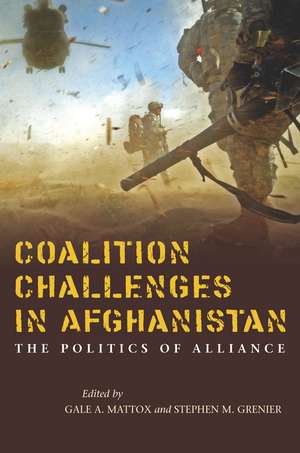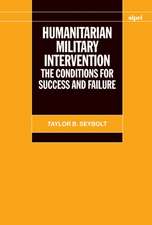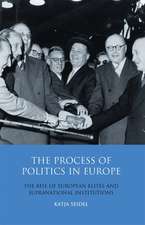Coalition Challenges in Afghanistan: The Politics of Alliance
Editat de Gale Mattox, Stephen Grenieren Limba Engleză Paperback – dec 2015
The book dissects the changes in the coalition over the decade, driven by both external factors—such as the Bonn Conferences of 2001 and 2011, the contiguous Iraq War, and politics and economics at home—and internal factors such as command structures, interoperability, emerging technologies, the surge, the introduction of counterinsurgency doctrine, Green on Blue attacks, escalating civilian casualties, and the impact of the Provincial Reconstruction Teams and NGOs.
In their conclusion, the editors review the commonality and uniqueness evident in the country cases, lay out the lessons learned by NATO, and assess the potential for their application in future alliance warfare in the new global order.
| Toate formatele și edițiile | Preț | Express |
|---|---|---|
| Paperback (1) | 246.48 lei 6-8 săpt. | |
| Stanford University Press – dec 2015 | 246.48 lei 6-8 săpt. | |
| Hardback (1) | 725.00 lei 6-8 săpt. | |
| Stanford University Press – dec 2015 | 725.00 lei 6-8 săpt. |
Preț: 246.48 lei
Nou
47.17€ • 48.73$ • 39.24£
Carte tipărită la comandă
Livrare economică 19 martie-02 aprilie
Specificații
ISBN-10: 0804796270
Pagini: 352
Dimensiuni: 152 x 229 x 23 mm
Greutate: 0.52 kg
Editura: Stanford University Press
Colecția Stanford Security Studies
Recenzii
Notă biografică
Cuprins
This chapter outlines the motivations that influenced a country's decision to join the coalition's campaign to stabilize Afghanistan. In addition, the chapter assesses the coalition's performance since 2001 by examining how well each country employed its military, diplomatic, or economic capabilities. Whether it was to demonstrate solidarity with the US or to avenge the deaths of their citizens during the September 11, 2001, terrorist attacks, several countries joined the coalition to defeat al Qaeda and bring Osama bin Laden to justice. Contributing nations conducted a wide-range of air, ground, and naval combat operations while others focused on delivering a distinctive capability that addressed a specific operational gap. When the interests of contributing members did not align, the coalition often failed to achieve its political and military objectives.
This chapter examines the role of the Afghan state in the country's war effort. Kabul is often treated as a non-entity ¿ a set of institutions acted upon by outsiders. The Afghan government is often seen by international actors as no more than traditional networks of patronage, yet there is also an elusive Afghan state attempting to exert itself. The conflicts inside the Afghan government are many-layered and opaque. Outcomes in Afghanistan are products of the interaction of these competing influences. International actors undermined state-building efforts in favor of parochial war aims, and traditional networks have subverted governance through corruption and modernization efforts has often flouted the culture and will of rural Afghans, focusing disproportionately on desires of the urban citizenry.
This chapter focuses on the relationships between ISAF contributing nations and Afghan warlords between 2001 and 2014. It shows how the latter have instrumentalized the cross-cutting agendas of the former to maximize their autonomy and shape the state-building process. It focuses on two typical warlords, General Dostum, the Uzbek leader of Northern Afghanistan, and Ismail Khan, the self-proclaimed "Amir of Western Afghanistan," and their ability to adapt to new environments, shape shift, and eventually survive, both physically and politically. It explains how these non-state armed actors have developed their own kind of diplomacy and taken advantage of the heterogeneity of the international community to resist Kabul's homogenizing pressure and remain relevant after 2001. Overall, this chapter demonstrates how warlords keep wielding influence in the midst of a state-building project that promotes the construction of bureaucratic institutions.
This chapter argues that the United States military, through a series of intentional and unintentional actions, hindered the creation of an effective Afghan National Army (ANA). The absence of an effective ANA was a key reason the security situation steadily deteriorated, eventually becoming so dire that in 2009, Secretary of Defense Robert Gates relieved General David McKiernan, the commander of all US and coalition troops in Afghanistan, and President Obama ordered a "top-to-bottom" policy review. American military officials put parochial interests ahead of Afghanistan's security needs and harmed the nascent ANA by working with local militia forces, using US Army National Guard units to train the ANA, and creating specialized units within the ANA. These actions undermined the ANA's combat effectiveness, harmed the legitimacy of the fledgling Afghan government, and served as a catalyst for corruption and patronage.
Canada's Afghanistan war experience differed from previous conflicts in one very significant fashion ¿ national implementation of an integrated governmental approach to military operations. This "whole of government" (WoG) approach defined Canada's involvement in Afghanistan, particularly between 2006 and 2011 in the southern province of Kandahar. This chapter examines the development of this WoG methodology and provides a perspective on evolving Canadian approaches to the use of its instruments of national power in the twenty-first century.
This chapter argues El Salvador's President Mauricio Funes sought to improve his relationship with the El Salvador Armed Forces by strengthening his country's ties with the US. The steady flow of illegal narcotics and weapons through the Central American isthmus caused an epidemic of gang-related violence. Funes needed the military's support to fight the gangs, but distrust between his leftist administration and the ESAF stood in the way of a coordinated response. He stunned political observers when he dismissed his own political party's concerns and joined with conservative legislators to approve the deployment of El Salvadoran troops to Afghanistan. The US responded by providing the troops with advanced training and equipment for use in Afghanistan, and against transnational criminal organizations operating in El Salvador. This strengthened El Salvadoran-American relations, improved Funes' standing with the ESAF, and helped San Salvador develop a better-coordinated government response against criminal entities.
A member of the International Security Assistance Force (ISAF), Germany has been the third largest contributor to the Afghan mission for over a decade and has committed the largest force second only to the United States for the Resolute Support post-2014 phase. For Germany this commitment by the Bundeswehr has reflected its commitment to Afghan development and has marked significant milestone in German responsibilities as an alliance member. Given its past decisions with respect to participation in conflict, the longer- implications of this role are less clear. There is no doubt that the leadership, training, and operational experience during the Afghanistan mission have been unprecedented for the country and its readiness for future deployments has significantly increased. But while its role in Afghanistan has given the Bundeswehr operational experience, it remains unclear if the country is ready for a more forward leaning international role for Germany in the future.
This chapter examines why a military campaign for which the British government had such high hopes, and which domestic public opinion initially supported, has led to major divisions within the UK and questions over its worth. The first part examines the first phase of Britain's Afghan War. It looks at the reasoning behind the government's decision to engage in combat in Afghanistan and then analyzes the initial campaign from 2001-2005. The second part reviews the second phase of the war. It considers the government's decision to make the case for NATO to escalate its involvement to Southern and Eastern Afghanistan and the subsequent deployment of British forces principally to Helmand. The third part reflects on the wider impact of the Afghan War for and on the UK.
Given that the Afghan campaign has often put great strain on US-European relations, it is of particular interest to consider the French example, traditionally the most unruly European NATO ally. After a historical overview, and looking at French contributions to ANA training, COIN and "civ-mil" policies, this article examines how the relationship between France and NATO has changed as a result of its 13 years-long engagement in Afghanistan. It argues that instead of driving France and the US further apart (as might have been expected during the crises in 2006/07), the campaign has actually reinforced many ties and contributed to a normalization of sorts, even though a great deal of ambiguity still characterizes the relationship.
This chapter highlights how a smaller power struggled with the political, military and financial pressures of sustained expeditionary operations and the dissonance that emerges as domestic political considerations clash with the military-operational reality. The Netherlands joined the coalition to rebuild its international standing and highlight the political and defense reforms it instituted after Dutch peacekeepers failed to prevent the 1995 murder of refugees in Srebrenica, a United Nations declared "safe area" in Bosnia. Since the Netherlands was dependent on the NATO collective security umbrella, the mission in Afghanistan provided an opportunity to increase its credibility within the Alliance and to strengthen the Dutch-American defense relationship. Dutch counterinsurgency operations in Uruzgan province proved politically contentious due to the combat involved, which ultimately became the pretext for the collapse of the government in 2010.
This chapter focuses on the participation and contribution of the Czech Republic, Slovakia, Hungary and Poland to the International Security Assistance Force (ISAF) mission in Afghanistan. The Visegrad Four's participation in ISAF, first and foremost, was rooted in the perception that it was NATO's key military operation. Each regarded ISAF's success as a key strategic interest critical to their goal of the continued viability of NATO, the cornerstone of their security. ISAF participation solidified the reputations of each as solid NATO "security providers." The chapter also examines how ISAF participation affected each state's military capabilities and ongoing efforts for military modernization and reform in the post-communist era. Perhaps, most importantly for all, NATO carried out the ISAF mission and remains intact to carry on its newfound global character.
This chapter examines how European allies of the United States applied COIN in Afghanistan by examining the experiences of the United Kingdom, Germany, the Netherlands and France. For several years after NATO assumed command of the International Security Assistance Force in Afghanistan (ISAF) in 2003, the United Kingdom struggled to relearn its forgotten COIN doctrine and strategy, while the Germans and French disputed how much NATO should engage in civilian reconstruction work. The Dutch kept a low-profile in this dispute while pursuing their own 'Dutch approach' in their area of responsibility. These divergences meant that ISAF was hobbled by an ad hoc patchwork of objectives without a clear consensus on a common strategy when confronted with the dual missions of nation-building and counterinsurgency.
The events of September 11, 2001 prompted NATO into action when it invoked Article V (collective defense) for the first time and subsequently led to the formation of the International Security Assistance Force - Afghanistan (ISAF). The following chapter provides a chronological analysis of the Alliance's thirteen-year involvement in the war in Afghanistan and examines the various strategic and political adjustments made by the now 28-member alliance. After its initially low profile, NATO expanded its activities throughout Afghanistan and assumed more and more combat missions. At first conceived of as primarily stabilization operations, ISAF's mission would eventually involve kinetic operations associated with counterinsurgency and counter terrorism. Although the Alliance made tremendous progress in adapting its strategy and tactics to an increasingly dangerous and challenging environment, the mission also exposed serious divisions and weaknesses as Brussels struggled with coordinating the national preferences and divergent capabilities of its member states.
Most accounts of the campaign in Afghanistan overlook the role of Jordan or the UAE. In official tallies and military terms their contributions have been miniscule and symbolic at best. Unlike others, neither has historically significant strategic interests in Afghanistan, and it would have been logical to free-ride on the already powerful coalition. But the fact that these countries publically joined the coalition highlights the complex reasons countries contributed to the campaign and illustrates remarkable flexibility in the form and substance of coalition burden sharing. We argue that their role must be considered in the context of their security environment, their relationship with the United States, and the larger pursuit of securing their interests against the threat of radical Islam, bolstering a national identity premised on more moderate interpretations of Islam, providing important diplomatic and strategic assets to the coalition.
This chapter examines Japan's contribution to the international coalition in Afghanistan. Tokyo supported coalition naval operations in the Indian Ocean to restore its credibility after the international community criticized Japan for exercising "checkbook diplomacy" during the 1991 Persian Gulf War when it contributed $13 billion to offset coalition expenses instead of deploying military forces to the region. If Japan had again assisted with only financial assistance, the Japan-United States alliance could have been undermined and Japanese national security threatened.
This chapter argues that Australia joined the international coalition to remove al Qaeda from their bases in Afghanistan; foster regional stability; and bolster the strength of Australia's US alliance by supporting the US in its pursuit of al-Qaeda. Australia supported action in Afghanistan to remove the al Qaeda threat and to deny that transnational organization and affiliated networks sanctuary to plan, arm and train in Afghanistan. Australian government was also concerned about al-Qaeda's impact on Australia's regional security. Lastly, Australian policy makers have sought to maintain US regional presence, bolster Australia's alliance stocks, and enhance the possibility of reciprocity from the larger power in alliance relations.
Never large in a quantitative sense, New Zealand's military deployment to Afghanistan is notable for its length and diplomatic significance. New Zealand's experience of casualties was the reverse of most, with the majority of New Zealand combat deaths coming in the last years of the Provincial Reconstruction Team's deployment to Bamiyan. The most domestically controversial part of New Zealand's commitment to Afghanistan, the Special Forces, was ironically often the most welcomed by its coalition partners. New Zealand's long commitment in Afghanistan formed a crucial element in the improving US-NZ security relationship, elements of which had been largely suspended since the mid-1980s. Afghanistan also provided the temporary glue for closer New Zealand-NATO links.
The role of Pakistan as an ally in the war on terror is unique. Unlike other allies discussed in this volume, Pakistan has not contributed military forces or other resources to support Coalition operations inside Afghanistan. This chapter argues that the Pakistani military forces play roles that affect Coalition operation in Afghanistan in several ways, both positive and negative. First, Pakistani military and paramilitary forces man the border outposts on the Durand Line, monitoring and at least theoretically constraining movement by militants across the border. Second, Pakistan's intelligence services have monitored and arrested members of certain militant groups that threaten the Coalition in Afghanistan, and that potentially threaten the homelands of Coalition partners. Third, and much more controversially, Pakistan's military and intelligence agencies provide sanctuary, shelter, and support for militant groups that actively fight the Coalition.
This chapter argues that Russia shared the coalition's goal of creating a stable Afghanistan to reduce the flow of illegal narcotics and the spread of Islamist extremism, but Moscow also embraced the contradictory policy of calling for US and International Security Assistance Force troops to depart Afghanistan. Russia provided coalition forces with detailed intelligence gained during Soviet military operations in the 1980s, and it worked with several Central Asian nations to permit coalition non-lethal supplies to be transported through their countries along three supply routes that collectively formed the Northern Distribution Network.
The chapter reviews similarities and differences in the Afghanistan conflict 2001-2014 drawn from the experiences of 13 selected country case studies involved in the International Security Assistance Force (ISAF), 2 neighboring countries, and Afghanistan. It concludes that addressing identified challenges in NATO's first role outside Europe has strengthened the alliance in many respects. Less certain is the alliance preparedness for future conflicts. The cooperation and collaboration of 50 diverse nations (NATO members as well as non-members) that evolved during the Afghanistan operations ¿ at times bumpy, at times surprisingly smooth ¿ set a new standard for future operations from which much can be learned. However, the road ahead will be difficult for Afghanistan and incorporating lessons learned for NATO and its coalition allies will be challenging.
















